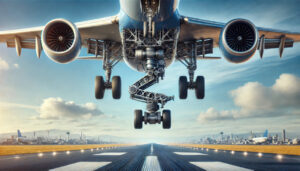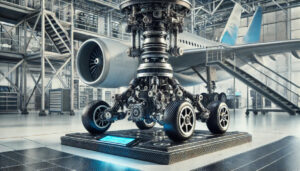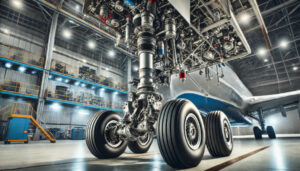The Commercial Aircraft Landing Gear Market is a vital segment of the aviation industry, playing a crucial role in aircraft operations, safety, and performance. With the growth of air travel, airlines are increasingly focused on modernizing their fleets, leading to a rise in demand for advanced landing gear systems. Technological advancements, sustainability initiatives, and the need for lightweight, fuel-efficient components are shaping the future of landing gear solutions.
The market is witnessing strong growth, driven by increasing aircraft production, demand for fuel efficiency, and a focus on reducing operational costs. The integration of lightweight materials, advanced braking systems, and smart monitoring technologies is revolutionizing landing gear designs. Additionally, sustainability efforts, including electric taxiing and composite materials, are influencing manufacturers to innovate more eco-friendly solutions.
Market Growth and Key Drivers
The Commercial Aircraft Landing Gear Market is experiencing steady growth due to several factors. One of the primary drivers is the increasing global air passenger traffic, which is fueling new aircraft production. Major aircraft manufacturers like Boeing and Airbus are ramping up their production capacities to meet the rising demand for air travel, directly impacting the landing gear market.
Another key driver is the adoption of lightweight and durable materials. The aviation industry is moving towards carbon fiber composites and titanium alloys, reducing the weight of landing gear systems. This shift enhances fuel efficiency, lowers emissions, and supports airlines’ sustainability goals.
Technological advancements are also playing a significant role in market expansion. Innovations such as electrically actuated landing gear systems, smart sensors for real-time monitoring, and predictive maintenance solutions are enhancing the operational efficiency and safety of commercial aircraft.
Download Pdf Brochure: https://www.marketsandmarkets.com/pdfdownloadNew.asp?id=1054
Restraints Impacting Market Growth
Despite significant growth prospects, the Commercial Aircraft Landing Gear Market faces certain challenges. One of the primary restraints is the high cost of advanced landing gear systems. The integration of next-generation technologies increases manufacturing costs, making it difficult for smaller airlines to afford modernized landing gear solutions.
Another challenge is the stringent regulatory requirements. Aviation authorities such as FAA (Federal Aviation Administration) and EASA (European Union Aviation Safety Agency) impose strict safety regulations on landing gear design, manufacturing, and maintenance. Compliance with these regulations demands significant investment in research, development, and testing, which can slow down innovation.
Additionally, supply chain disruptions and raw material shortages have impacted aircraft component manufacturing, including landing gear systems. The industry has witnessed fluctuations in raw material availability, production delays, and increased costs, creating challenges for market players.
Opportunities in the Commercial Aircraft Landing Gear Market
Despite these challenges, the Commercial Aircraft Landing Gear Market presents lucrative opportunities for growth. One of the biggest opportunities is the rising demand for next-generation aircraft. With airlines focusing on fuel-efficient, long-range aircraft, the need for advanced landing gear systems is increasing.
Another significant opportunity is the adoption of Predictive Maintenance Solutions (PMS). The integration of Internet of Things (IoT), Artificial Intelligence (AI), and Machine Learning (ML) in landing gear systems allows real-time monitoring, early fault detection, and optimized maintenance schedules. This reduces aircraft downtime, operational costs, and unexpected failures.
The trend of urban air mobility (UAM) and electric aircraft also opens new avenues for the market. As electric and hybrid aircraft gain popularity, the need for lightweight, energy-efficient landing gear is increasing, offering new opportunities for manufacturers to develop specialized landing gear systems.
Key Market Segments
The Commercial Aircraft Landing Gear Market is segmented based on type, aircraft category, and end-user.
By Type:
- Main Landing Gear: The primary support system for aircraft during landing and taxiing.
- Nose Landing Gear: Provides stability and steering for the aircraft while on the ground.
By Aircraft Category:
- Narrow-Body Aircraft: Used for short-haul and medium-haul flights, with rising demand due to increasing domestic air travel.
- Wide-Body Aircraft: Designed for long-haul international travel, requiring robust landing gear systems.
- Regional Jets & Business Jets: Smaller aircraft with specialized landing gear requirements.
By End-User:
- OEMs (Original Equipment Manufacturers): Aircraft manufacturers integrating landing gear into new aircraft.
- Aftermarket Services: Maintenance, repair, and replacement of landing gear systems.
Regional Analysis
North America: North America holds a dominant position in the Commercial Aircraft Landing Gear Market, driven by strong presence of leading aircraft manufacturers such as Boeing and Bombardier. The region is also witnessing increased investments in research and development for next-generation landing gear systems.
Europe: Europe is another significant market, led by Airbus and Safran Landing Systems. The region’s focus on lightweight materials, electrification of aircraft components, and sustainable aviation initiatives is accelerating market growth.
Asia-Pacific: Asia-Pacific is projected to experience the highest growth rate, fueled by increasing air traffic, rising demand for new aircraft deliveries, and expanding maintenance, repair, and overhaul (MRO) services in countries such as China, India, and Japan.
Rest of the World (RoW): Regions such as the Middle East, Latin America, and Africa are also witnessing growth due to rising airline expansions and airport infrastructure development. The Middle East, in particular, is focusing on luxury air travel and fleet modernization, boosting demand for advanced landing gear solutions.
Competitive Landscape: Key Players
The Commercial Aircraft Landing Gear Market is highly competitive, with several global and regional players. Major companies in the market include:
- Safran Landing Systems (France)
- Collins Aerospace (US)
- Liebherr Aerospace (Switzerland)
- Heroux-Devtek (Canada)
- CIRCOR Aerospace (US)
- Sumitomo Precision Products (Japan)
- GKN Aerospace (UK)
These companies are investing heavily in research and development, mergers and acquisitions, and technological innovations to enhance their market position.
Ask For Sample Report: https://www.marketsandmarkets.com/requestsampleNew.asp?id=1054
Future Outlook of the Market
The Commercial Aircraft Landing Gear Market is set for remarkable growth, with trends such as electrification, lightweight materials, and smart monitoring systems shaping the industry’s future. As airlines continue to modernize their fleets, the demand for fuel-efficient and durable landing gear solutions will surge.
Advancements in additive manufacturing (3D printing), composite materials, and artificial intelligence will further drive innovation in landing gear technology. The rise of autonomous aircraft and electric air taxis will also push manufacturers to develop specialized, compact, and lightweight landing gear solutions.
The Commercial Aircraft Landing Gear Market is poised for significant expansion, driven by increasing air travel demand, fleet modernization, and technological advancements. While challenges such as high costs and regulatory constraints persist, opportunities in predictive maintenance, urban air mobility, and sustainable solutions will shape the market’s future.
Leading industry players are actively innovating to enhance landing gear efficiency, durability, and safety, ensuring continued growth in this crucial aviation sector. With a focus on lightweight materials, smart technologies, and electric aircraft support, the market is on track for sustained evolution in the coming years.



